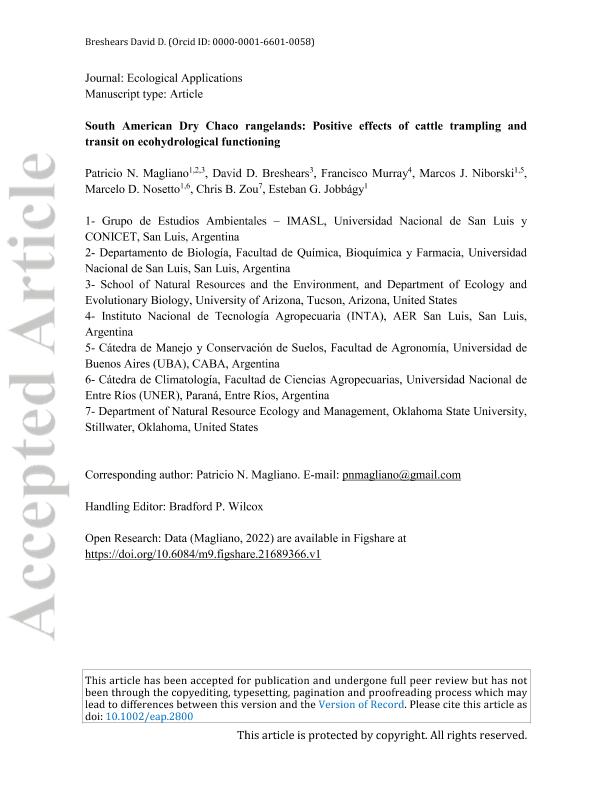Mostrar el registro sencillo del ítem
dc.contributor.author
Magliano, Patricio Nicolás

dc.contributor.author
Breshears, David D.
dc.contributor.author
Murray, Francisco

dc.contributor.author
Niborski, Marcos Javier

dc.contributor.author
Nosetto, Marcelo Daniel

dc.contributor.author
Zou, Chris B.
dc.contributor.author
Jobbágy, Esteban G.
dc.date.available
2024-02-19T14:31:28Z
dc.date.issued
2023-04
dc.identifier.citation
Magliano, Patricio Nicolás; Breshears, David D.; Murray, Francisco; Niborski, Marcos Javier; Nosetto, Marcelo Daniel; et al.; South American Dry Chaco rangelands: Positive effects of cattle trampling and transit on ecohydrological functioning; Ecological Society of America; Ecological Applications; 33; 3; 4-2023; 1-19
dc.identifier.issn
1051-0761
dc.identifier.uri
http://hdl.handle.net/11336/227459
dc.description.abstract
Livestock production in drylands requires consideration of the ecological applications of ecohydrological redistribution of water. Intensive cattle trampling and the associated increase of surface runoff are common concerns for rangeland productivity and sustainability. Here, we highlight a regional livestock production system in which cattle trails and trampling surrounding an artificial impoundment are purposely managed to enhance redistribution and availability of water for cattle drinking. Based on literature synthesis and field measurements, we first describe cattle production systems and surface water redistribution in the Dry Chaco rangelands of South America, and then develop a conceptual framework to synthesize the ecohydrological impacts of livestock production on these ecosystems. Critical to this framework is the pioshere—a degraded overgrazed and overtrampled area where vegetation has difficulties growing, usually close to the water points. The Dry Chaco rangelands have three key distinctive characteristics associated with the flat sedimentary environment lacking fresh groundwater and the very extensive ranching conditions: (1) cattle drinking water is provided by artificial impoundments filled by runoff, (2) heavy trampling around the impoundment and its adjacent areas generates a piosphere that favors runoff toward the impoundment, and (3) the impoundment, piosphere, and extensive forage areas are hydrologically connected with a network of cattle trails. We propose an ecohydrological framework where cattle transit and trampling alter the natural water circulation of these ecosystems, affecting small fractions of the landscape through increased runoff (compaction in piosphere and trails), surface connectivity (convergence of trails to piosphere to impoundment), and ponding (compaction of the impoundment floor) that operate together making water harvesting and storage possible. These effects have likely generated a positive water feedback on the expansion of livestock in the region with a relatively low impact on forage production. We highlight the role of livestock transit as a geomorphological agent capable of reshaping the hydrology of flat sedimentary rangelands in ways that can be managed positively for sustainable ranching systems. We suggest that the Dry Chaco offers an alternative paradigm for rangelands in which cattle trampling may contribute to sustainable seminatural production systems with implications for other dry and flat rangelands of the world.
dc.format
application/pdf
dc.language.iso
eng
dc.publisher
Ecological Society of America

dc.rights
info:eu-repo/semantics/openAccess
dc.rights.uri
https://creativecommons.org/licenses/by-nc-sa/2.5/ar/
dc.subject
ARID
dc.subject
CONNECTIVITY
dc.subject
DESERTIFICATION
dc.subject
LAND COVER CHANGE
dc.subject
LAND USE CHANGE
dc.subject
LIVESTOCK
dc.subject
PIOSPHERE
dc.subject
RUNOFF
dc.subject
SOIL COMPACTION
dc.subject.classification
Oceanografía, Hidrología, Recursos Hídricos

dc.subject.classification
Ciencias de la Tierra y relacionadas con el Medio Ambiente

dc.subject.classification
CIENCIAS NATURALES Y EXACTAS

dc.title
South American Dry Chaco rangelands: Positive effects of cattle trampling and transit on ecohydrological functioning
dc.type
info:eu-repo/semantics/article
dc.type
info:ar-repo/semantics/artículo
dc.type
info:eu-repo/semantics/publishedVersion
dc.date.updated
2024-02-19T10:39:27Z
dc.journal.volume
33
dc.journal.number
3
dc.journal.pagination
1-19
dc.journal.pais
Estados Unidos

dc.description.fil
Fil: Magliano, Patricio Nicolás. University of Arizona; Estados Unidos. Consejo Nacional de Investigaciones Científicas y Técnicas. Centro Científico Tecnológico Conicet - San Luis. Instituto de Matemática Aplicada de San Luis "Prof. Ezio Marchi". Universidad Nacional de San Luis. Facultad de Ciencias Físico, Matemáticas y Naturales. Instituto de Matemática Aplicada de San Luis "Prof. Ezio Marchi"; Argentina
dc.description.fil
Fil: Breshears, David D.. University of Arizona; Estados Unidos
dc.description.fil
Fil: Murray, Francisco. Instituto Nacional de Tecnología Agropecuaria; Argentina
dc.description.fil
Fil: Niborski, Marcos Javier. Instituto Nacional de Tecnología Agropecuaria. Centro Regional Buenos Aires; Argentina. Consejo Nacional de Investigaciones Científicas y Técnicas. Centro Científico Tecnológico Conicet - San Luis. Instituto de Matemática Aplicada de San Luis "Prof. Ezio Marchi". Universidad Nacional de San Luis. Facultad de Ciencias Físico, Matemáticas y Naturales. Instituto de Matemática Aplicada de San Luis "Prof. Ezio Marchi"; Argentina
dc.description.fil
Fil: Nosetto, Marcelo Daniel. Consejo Nacional de Investigaciones Científicas y Técnicas. Centro Científico Tecnológico Conicet - San Luis. Instituto de Matemática Aplicada de San Luis "Prof. Ezio Marchi". Universidad Nacional de San Luis. Facultad de Ciencias Físico, Matemáticas y Naturales. Instituto de Matemática Aplicada de San Luis "Prof. Ezio Marchi"; Argentina. Universidad de Buenos Aires; Argentina
dc.description.fil
Fil: Zou, Chris B.. Universidad Nacional de San Luis; Argentina
dc.description.fil
Fil: Jobbágy, Esteban G.. Universidad Nacional de San Luis; Argentina
dc.journal.title
Ecological Applications

dc.relation.alternativeid
info:eu-repo/semantics/altIdentifier/doi/https://doi.org/10.1002/eap.2800
dc.relation.alternativeid
info:eu-repo/semantics/altIdentifier/url/https://esajournals.onlinelibrary.wiley.com/doi/10.1002/eap.2800
Archivos asociados
